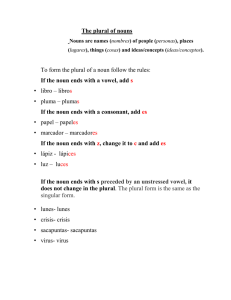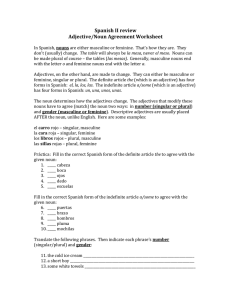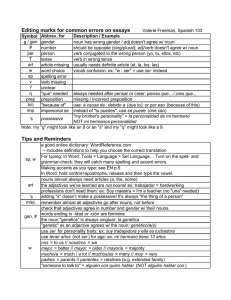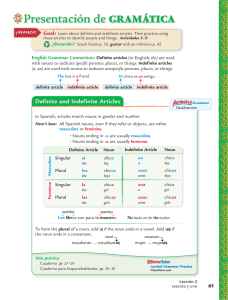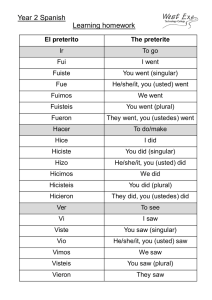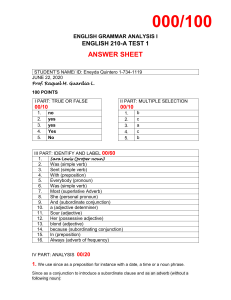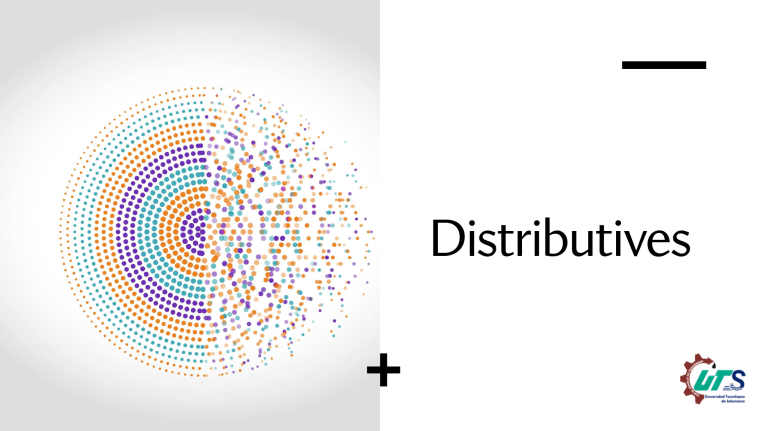
Distributives What is a distributive? – Distributive determiners refer to a group of people or things, and to individual members of the group. They show different ways of looking at the individuals within a group, and they express how something is distributed, shared, or divided. The nine commonly agreed upon distributives are: – all – any – both – each – either – every – half – neither – none Both, neither, and either The distributives both, neither, and either are used to refer to pairs. They can be used only for groups of two— no more, no less. – I’ll take both. – I’ll take either. – I’ll take neither. both Both means all in reference to two things. It is used before plural nouns. Example: – Both restaurants close soon. (not: Both restaurant close soon.) We can use both and both of before plural nouns with determiners such as the, a/an, those, her, etc. Examples: – Both the restaurants offer delivery service. = Both of the restaurants … However, we must use both of before object pronouns (us, them, etc.). The of is not optional in this case. Example: – Both of us are hungry. (not: Both us are hungry.) … both We can use both after a subject pronoun (you, they) to emphasise that we are referring to two things or people. In this case, both comes after an auxiliary verb or the verb be, but comes before other verbs. Example: – We are both hungry. – We both want to order food. Both … and is used to connect two things. We usually ensure that these things are of the same grammatical type so that the sentence sounds balanced. Example: – Both Italian and Chinese are out of the question. (noun + noun) – Their food is both vegan and gluten free. (adjective + adjective) neither Neither is the opposite of both. It also refers to two things but has a negative meaning. It means not one and not the other and is used before singular nouns. Example: – Neither restaurant delivers. (not The Chinese restaurant and not the Italian restaurant.) Neither can be used alone as a short answer. Example: – A: Do you drink tea or coffee? B: Neither. With an object pronoun (us, them, ours, etc.) or a plural noun with a determiner (the, those, her, etc.), we must use neither of. Examples: – Neither of us wanted to cook. (object pronoun) – Neither of the restaurants had a table. (plural noun with article) – Neither of her parents said goodbye. (plural noun with possessive pronoun) neither … nor Neither is combined with nor to connect two things or people. Example: – Neither the Chinese restaurant nor the Italian delivers. – Neither my girlfriend nor my best friend remembered my birthday. To express the idea of also not, we use neither followed by inverted word order: neither + auxiliary + subject. Example: – A: I don’t like Chinese. – B: Neither do I. We can also use not … either to express the same idea. Example: – I don’t like Chinese either. either Either is used before singular nouns to mean one or the other. Either … or presents a choice between two possibilities. Example: – Either option is fine for me. – I want either Italian or Chinese. Either can be used alone as a short answer. Example: – A: Which do you prefer? B: Either. With an object pronoun (us, them, you, etc.) or a plural noun with a determiner (the, a/an, my, these, etc.), we must use either of. Example: – I don’t like either of them. (object pronoun) – You can ask either of the waitresses. (plural noun with article) – We didn’t like either of those films. (plural noun with demonstrative pronoun) each, every We use each and every to mean all when referring to three or more things or people. They can often be used interchangeably: Example: – Each table in the restaurant was occupied. – Every table in the restaurant was occupied. However, there are also some small differences between each and every. each Each is used with singular nouns to focus on separate things in a group. It is used to emphasise individuals within a group and often appears with words such as individually, personally, etc. Example: – He thanked each guest personally. – There’s a new episode each week. – I read two reviews of the restaurant and each review said the same thing. We use each of before object pronouns (us, them, etc.) and nouns with determiners (such as the, a/an, her, these, etc.) Example: – We can find something for each of us. (object pronoun) – I told each of my parents individually. (noun with a possessive pronoun) every Example: – Every restaurant in this area delivers. – She works every third Saturday in the month. Every refers to all parts in a group of three or more. It can only be used with singular nouns. Unlike each, every is used for generalisations because it emphasises all elements within a group. We use adverbs such as almost, nearly, practically, single, etc. with every rather than each. Examples: – Practically every restaurant has an online menu nowadays. (not: Practically each restaurant has an online menu nowadays.) We cannot use every of. If we want to use every before a pronoun or a determiner, we must use every one of. Example: – I've seen every one of his movies. (not: I’ve seen every of his movies.) all All is used to refer to every element in a group of three or more people or things. It is used with plural nouns. Example: – All banks are closed on Sundays. If we have a noun with a determiner such as the, these, your, my, etc., we can use all or all of. Example: – All the restaurants close soon. = All of the restaurants close soon. With absolute pronouns that replace a noun, such as them, us, theirs, mine, etc. of is not optional. Example: – All of them close soon. (not: All them close soon.) We often use the construction not all with plural nouns to divide a group. Example: – Not all restaurants deliver. no We use no before a noun to mean not any or not one. The verb is conjugated accordingly. Example: – No restaurants deliver after ten o’clock. – No restaurant delivers after ten o’clock. – I have no time to cook. none of We use none of before pronouns (mine, them, us, ours, etc.) and before a noun with a determiner (the, your, my etc.) Example: – None of them deliver after ten o’clock. (object pronoun) – None of your emails arrived. (noun with a possessive pronoun) – None of the cake was eaten. (singular noun cake → verb in the singular) – None of the restaurants deliver after ten. (plural noun restaurants → verb in the plural) For two things we use the distributive neither. Example: – None of the restaurants deliver after ten o’clock. (a group of more than 2 restaurants) – Neither of the restaurants delivers after ten o’clock. (2 restaurants) half Half has the same meaning as the fraction, which is to say fifty percent. Half can be combined with singular nouns, plural nouns, and mass nouns, but you must also use an article (such as a or an), a singular or plural demonstrative, or a possessive noun. – She was asleep for half the movie. – Was the night out worth half your paycheck? Half can also be used on its own as a pronoun. – I can’t eat a whole slice, so just give me half. We must use of when using it with a pronoun. – Half of them have never even played baseball before. Additionally, half can be used with measurements, such as meters, pints, or minutes. In this construction, the measurement is always a singular noun with an indefinite article (a or an). – I need half an hour to get ready. – His car broke down half a mile from home.
